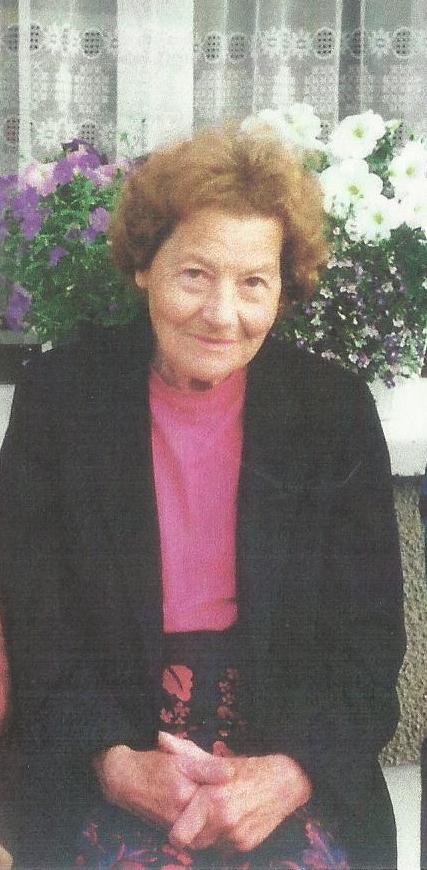Maureen Scanlan was born in 1915 in Abbey House, Killaloe.
Maureen was a great granddaughter of John Crotty, who owned Crotty’s on Main Street. She passed away in 2003 at the age of 88.
You can listen to Maureen’s interview from the early 1990’s here through Soundcloud!
John Crotty was my great-grandfather and he had only one child, one daughter Elizabeth, Eliza and she married a Peter Scanlon and actually he died before John Crotty, so that’s the connection with Crotty’s. And I can remember when I was small, the Canal Store and down there in the Mill, they used to bring up the coal and the grain and everything in the horse and cart, hauling it up and down, and the Guinness in the barrels.
Killaloe that time the waterways was the way of transport, even though there was a Railway but I think most of the stuff came by Canal by barge down.
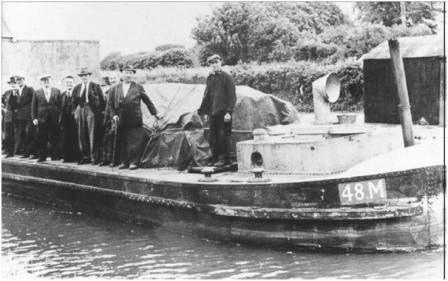
This is just something funny……..When my father got married, he bought Abbey House well he bought Abbey House in 1910 and he married in 1913 and he and my mother were in Paris on their honeymoon and they went to see a show this night and there were acrobats and things like that on the stage and then they brought out is it a special ‘turn’ they said and they brought out a whole lot of barrels and this chap came out and he started to jump from one barrel into another, or something like that, and my father started to laugh and Mom turned to him and said “what are you laughing at? What’s funny in that” and he said “to think that I came all this way to see that, my father used to do that in the barrels, in the Yard in Crotty’s and I’ve been looking at all my life”
He was a terrific athlete, he could jump over anything and when the English people would come over fishing and they used to stay in Graces, t’was a Fishing Lodge and there was a right of way, you know where Sean Ryan is and Carmel and there’s a right of way in the back of the two yards and there was always a right of way to Crotty’s, so the English people would be in there and they used to love to watch him doing this and if there was a horse and cart heeled up in the yard, he’d leap over the whole thing, he’d just think nothing of it.
And how many years was he in Crotty’s?
My father? Sure he was born there, until he died. He died in 1923 and my mother was only married that length of time and we were only kids. I don’t remember a lot about him to be honest sadly, and that’s the sad thing, you know, I mean if he’d lived on you know you could have asked him a whole lot of questions. Naturally my mother, that side of the family, she didn’t want to have anything to do with them, she was so upset and worried and everything, in those days they wore Widows Weeds for seven years until 1930. I mean it was more her own side of the family that I knew about then, sadly.
But I remember there was this walk between the waters to go down by the Canal and the old Mill, and you’d see all the grain and the maize and it could be in the barge and they had this kind of thing and they’d scoop it all up and then it was ground in the Mill. You could go down to the first Lock which was Magee’s and that was a walk we loved as children and then you went over the bridge, over the Canal and it dropped down and there was a Lock Keeper there cause they had to change the levels of the water, you see, I think Castleconnell is about seven feet lower than Killaloe, that’s why they had to have these Locks and there was one there at the Bridge and they would go changing the levels of the water when the barges would come in. Then the second Lock was Crowe’s and I never walked further than that because we were too small as kids and there were wild swans there and they were so wild that we were terrified of them, not like nowadays they’re tame.
I think I heard from somebody that there used to be races down there, horse races, I think it was in the month of April and you know women used to come out from Limerick, you know the ‘Maggie Women’, selling apples and things like that and they had all sorts of excitement. It was in a flat field, I think it was in Maloney’s land, somebody told me that but I don’t know where the riders came from or anything. I don’t remember it.
Bridget Tully told me, she remembers going down there as children, walking down there and seeing where the races were. But she’s a bit is older than me. I mean I don’t remember it.
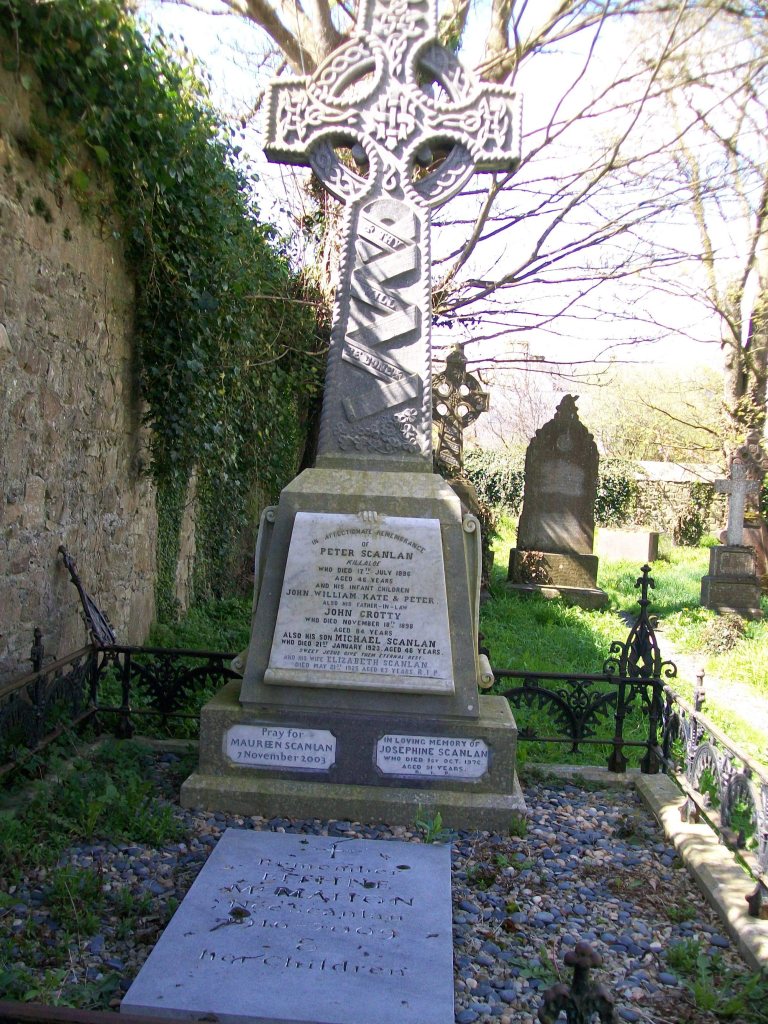
Maureen, where would you grandfather have come from?
Now that’s what I don’t know, because he started Crotty’s. But I mean, I was out with the McGrath’s when they took it over but I don’t know where they got all those dates from, you know, it was in the paper that it was eighty years old but I went down and took it off the tombstone so I mean my grandmother was born in about 1840, so he must have been married before then, that was John Crotty, she was John Crotty’s daughter, so I don’t know where he came from, unfortunately, it’s very sad now, I’ve no one to ask but with my father dying, we used never think about that – where we came from. He’s the first recorded on the tombstone.
They would have made a good living there?
Presumably, yea! That and McKeogh’s, across the bridge, they were the two big stores around.
They employed a lot of people, didn’t they?
They employed about 20 hands. They used to have butter that used to come in from the country, the farmers would bring it in in their horse and carts, from Ogonnelloe especially and that’d be sent off down to Cork, and that happened every Monday. Then you see all the things that you get in the Creamery now, feeding stuffs was all sold there and sure everything had to be weighed in those days. There were four girls at the counter, two girls in the Hardware, there was a girl in the Bar, a girl in the Cash Office and there was a man in the back Office, there was a lad weighing and there were a whole lot of men. There was a Bakery of course, the Moore’s, you know the Moore’s down in New Street, well there was Paddy and there was old James Moore, and then there an old man there, his father before him, old James, and they came from Roscrea, they always made lovely bread.
Were McKeogh’s not a bakery then?
Oh it was.
So there was great competition?
There was great competition, there was great rivalry between the two. They were poles apart, not getting on and all that!
And coal of course. They went around, they had a horse-drawn van for delivering the bread and I think the bread used to be delivered maybe twice a day anyway all around the town with it and another lot came out, hot bread.
And I’m sure it tasted a lot better than today’s bread!
The Moore’s oh they were wonderful, old Jas Moore, all during the War, my mother never had to taste the white bread, it was horrible, t’was kind of grey in colour and he used to make a little loaf for her every day, he used to sieve the flour through a silk stocking so that she’d have a pure white loaf, he thought so much of her, you know he was a dear really, old Jas that would be Paddy’s father.
So you were never there as a child – your family had bought Abbey House?
We were living in Abbey House but my mother ran it.
Do you remember it?
Crotty’s? Of course I do. When did we sell it? 1950’s, Mom had been ill, she’d had a major operation. Maybe 1955?
Did you work there Maureen?
Not really, I helped out a little bit in it but we had a huge staff, but I didn’t really. I didn’t take it over because t’was a hard life kind of. We had land that time, the farm and land and the garden.
So you had plenty to do!
We had plenty to do.
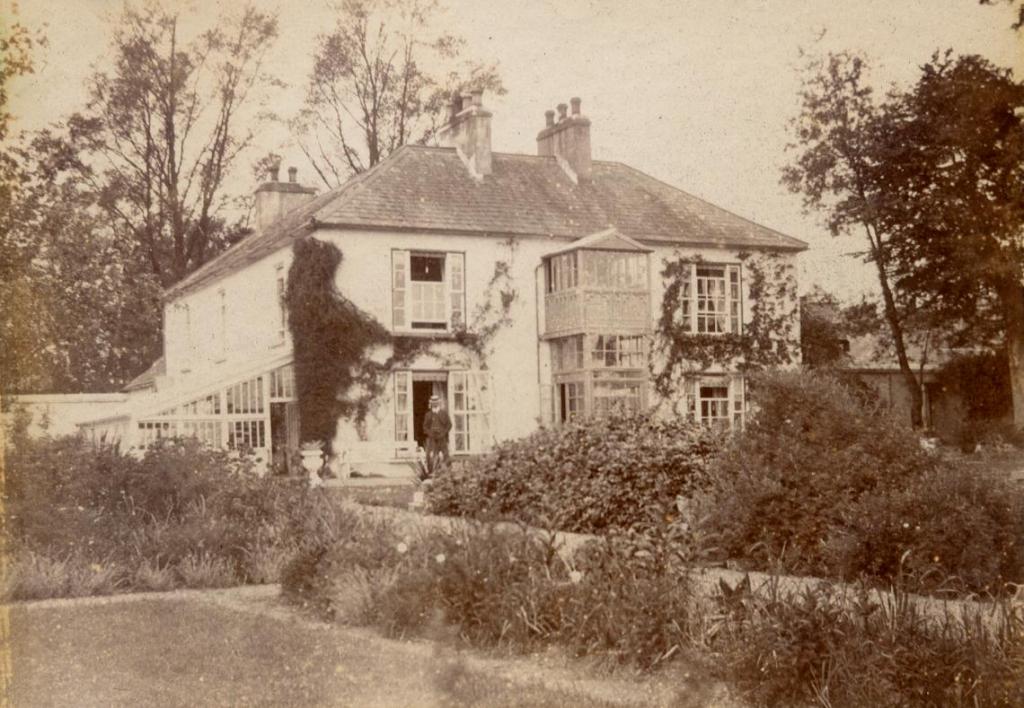
So when did your family buy Abbey House?
1910.
And who did they buy it from?
They bought it from the Church Body. The Church Body were putting it up for sale you see and there was a Mrs. Forde in it, she was renting it and my father left her in it and when she died, her husband had been out in the Indian War and they had alot of stuff, it was mostly basket furniture and swords and things and he wouldn’t have an auction he just gave them a price. They had old swords and daggers and things and the Flag of King Theobald, the last King of Burmah, when they got his Flag he had to capitulate and his umbrella. We offered them to a Museum.
And how did they come to have those?
They were loot, you see Mrs. Forde’s husband was in the Army, a Colonel, she was a widow then, and this was loot from the palace, you know what they did in those days. There were teak…we had an old dragon thing and there was teak and gilt, painted over gilt. Will I tell you this?
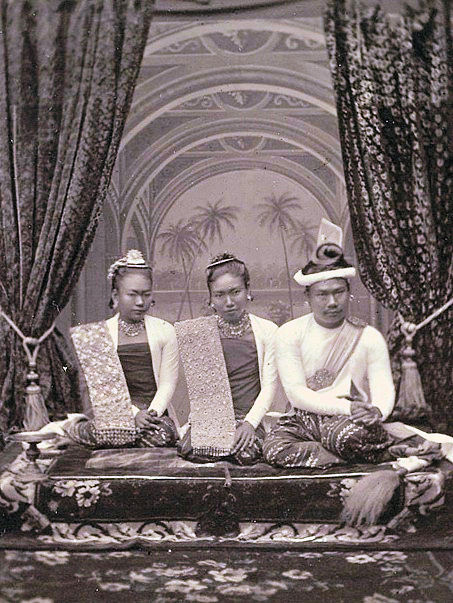
Yes, please do.
King Theobald, the last King, he had four angels on his bed, the two good ones and the two bad ones, the four posters of the bed. There was one of them in a Museum in London and there was one in America and there was out in one Burmah and my uncle by marriage, married to my aunt, he was in the Civil Service and he was in Burmah and he was writing a history of it and there was somebody there that he was going to get a loan of this golden boy and he was going to get it copied and he would write copy, he promised to write copy underneath and he, the owner, agreed but then at the eleventh hour the owner decided no, he wouldn’t allow it to be copied.
My uncle was very disappointed naturally and he was back in London and he was engaged to my aunt. Mom and Dad were married at this stage, a couple of years. So she brought him over to stay in Abbey House and they were telling this story and he said if only he knew where the fourth Golden Boy was and my father said, “Joe” he said, “haven’t we got that Golden Boy”. “Ah now Michael Scanlan” he said, “don’t be joking me” because he was an Englishman and he was too serious and he didn’t believe him.
But some of our relatives, they put it in somebody’s bed, you know, as a joke, and he put it outside the door of the bedroom to prove that he had found it, you know and I suppose the maid in the morning, she just put it up in the trunk room up in the attic and it was lying up there all the time. I remember it alright, it was on a wooden stand and he had a little red loin cloth around him and we used to play with him.
Wasn’t it the Golden Boy that they had searched the World for and to think that they should find it in his perspective in-laws house, in Killaloe in a village. And he put it in his book, he wrote a History of Burmah, but sadly my father died not too long after and he thought it would be too hurtful for my mother to see it written so he left it out and sadly because now, I mean it would be nice to read.
Was it valuable Maureen?
No I wouldn’t think so, but it was just the sentiment to them.
We had the Flag, that nobody wanted, so we gave him that, we gave it to him as a wedding present, we couldn’t have given him anything else, he had everything he wanted. He gave a lecture then in London afterwards and we shipped it over, we wrapped it up in yards and yards of cotton wool and shipped it across, but t’was very easy then, you just put a parcel on the train, the four o’clock train that went out to Birdhill and anything was in London the following morning, we used to often send fish in those days, and now, planes and everything and it doesn’t mean anything. It was a wonderful postal service.
And how would it get there so quick?
It went up to Dublin, over in the boat, down to Euston, it went in to Euston at six in the morning.
Well it certainly isn’t like that now!
It is not!
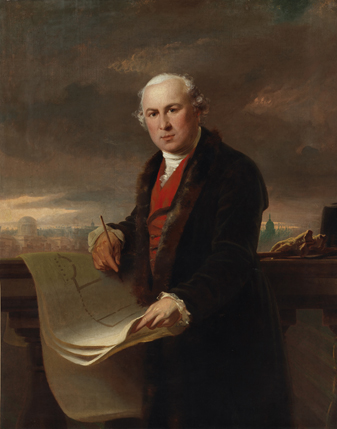
What about this story of a Gandon House – will you tell me about that?
It was about 1963 that John O’Donovan, the historian, living in Dublin, well he came down, he had been talking to alot of American students in a Gandon School in America and they were very interested in Gandon work and they were looking at some ruins in the diocese of Ferns, it was supposed to be a Palace and there was a Dean Burke down there and John O’Donovan got interested in it and he discovered that Gandon had built a house for his friend, Dean Burke in the Diocese of Ferns. Then he found out that Dean Burke had been transferred to Killaloe and he came down here looking up where it was, he tried Clarisford and it wasn’t there, it wasn’t old enough, they tried Ferns Hollow and that wasn’t right so he came to Abbey House and he decided it was Abbey House, as it had been a Rectory or a Deanery, he went back and got alot of photos and he found where there was a little path going from Abbey House garden into the Cathedral, private part, through the yard and from the photos he decided it was a Gandon House. He then said the stairs in the house was Gandon and the little hall, the decoration on the ceiling was Gandon but it seems when Hugh Weir was writing his book he seems to think that Gandon wasn’t in Killaloe at that time so he didn’t seem to think how it could be, but sadly John O’Donovan is dead so we never disputed the thing, just wondering if it could be or could not be? I imagine, I think it must be because when it was built Dean Burke was there.
And there was never anything on deeds or anything to say?
No we never found that, we only found going back to 1840 when the Martins were in it, I mean our solicitor had it going back that far, the deeds didn’t go back any further than 1840.
Didn’t a Spaight live in it?
A Spaight lived in it but all these people that were living in it were only renting it from the Church Body. It probably would have been before Mrs. Forde and she was a widow, she was a kind of recluse, she just lived in one room, a bedroom, up stairs, she had the servants naturally in those days, but she was alone.
There is a little pane of glass in the window of what was my mother’s bedroom, it’s terribly thin glass, it’s amazing how it hasn’t cracked or anything. Peg Martin, December 24th 1824 was scratched on it and these Martins of course, were living in it in 1840. A relation of theirs in South Africa being a Martin, and she came over to write the history of all the Martin family and she was a terribly nice woman, and she went down, she got an awful lot of information from Seán Kierse of course. When she was writing this history, she told us that the Martin Family had built the present Deanery and when they were leaving Killaloe, I don’t know when that was, they presented it to the Church Body and that was it then, they decided they’d move and they’d make that their Rectory and they’d put Abbey House on the market and that’s how my father bought it. And there was a Mrs. Forde in it and he left her in it because he didn’t want to live it then because he wasn’t married.
So he lived there and just continued still to work in Crotty’s, continued to run his business?
Oh of course, he went up every day and he ran it.
When Peter Scanlon, his father, died he was only 19 I think, and the other brother was wild so I mean he had responsibility at a young age, and his mother of course, she helped in the business too, I remember Granny, she died after him, she died in 1925.
Can you ever remember anything that your grandmother would have told you?
No I don’t, sadly I haven’t anything at all like that, because in those days we’d a very sheltered childhood you know, we had a nurse and we were up in the nursery, you were segregated from your elders, not like nowadays. Even though I was old enough to mix around with people, we had Governesses and people looking after us you know what I mean. We were only taken out on state occasions (laughing).
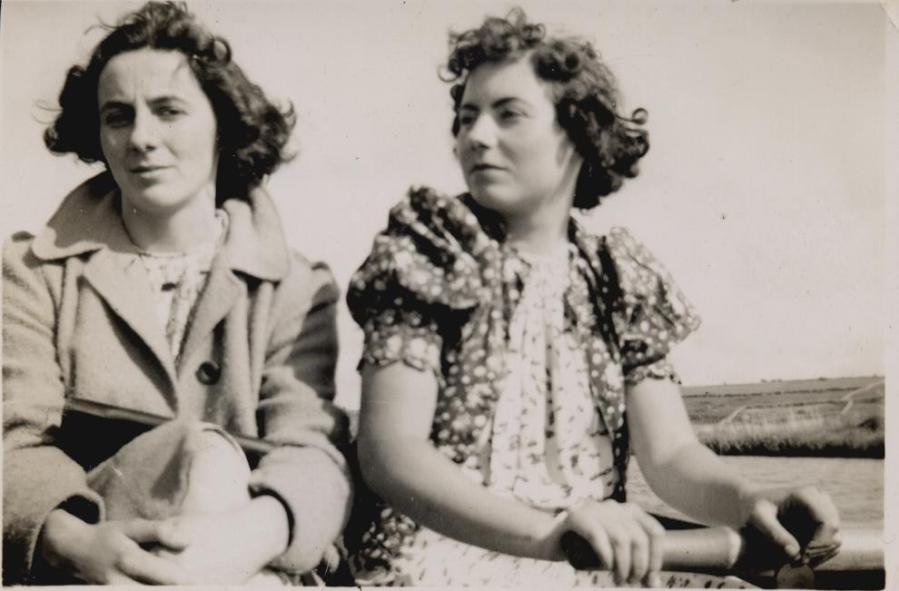
Where did you go to school or did you have private tuition?
I went to school in England actually. We had private tuition until I was thirteen and of course in those days, my father had just died in 1923 when we became Independent after the Civil War, we separated you know from England. We knew they would be teaching Irish in the schools and we didn’t know any Irish so it was thought that it would be rather a handicap to go away to a sort of a boarding school in Ireland when we didn’t know any, I don’t know whether it would have but that’s what my mother said.
And we had this aunt in England who was very keen on education and my mother wanted us to go over there so we did.
So you just came home on holidays?
Came home on holidays, yea.
You must have felt very isolated?
We did terribly, yea. It was a mistake in a way because we hadn’t any Irish friends.
And what age did you finish school?
About seventeen and then I went abroad for a year, I went to Switzerland.
Then I went to Austria for a couple of weeks, because a friend of my mothers in Limerick, her sister had gone, there wasn’t much to do, this would have been before the Great War, she went out you wouldn’t call in au-pairing in those days, but you know teaching English for her family, because there was very little for girls to do in the olden days and she married this Austrian and he was killed in 1914 War and she had just one daughter and we knew her sister in Limerick, she was a Doctor, Dr. O’Sullivan, and they were great friends of ours so I went there and I stayed with them for about two months after I left Switzerland school, before I came home. I saw quite a bit of the world, at a young age.
Your memories of Killaloe from your childhood and growing up and everything, what can you remember?
I don’t remember a lot. Did you know that there was a Golf Links in Killaloe in the old days?
No.
It might have being going years and years ago but there was a Bank Manager here, Andrews, Cyril Andrews, I think he came in 1927? And he was very keen on sport and all that kind of thing, he done a lot of shooting and any kind of a game and he started it.
T’was in Rohan’s land. I don’t know what the estate is called now, it’s out the Portroe Road and it goes down to the lake and it’s all covered in bracken.
Well there was a nine-hole golf course made there and the unique thing about it was that you could only play in the winter. Rohan’s wanted the land for hay so they had to close it off in April and they grazed it in the winter then. The greens had to be surrounded by barbed wire so that the cattle you know wouldn’t walk across. They’d an awful lot of work to do but anyway they had apparently great fun. They used to have the people around, like what they would do in the ICA now you know, so one person would be hostess and have tea and I think it was a Thursday afternoon and people would go and play.
For men only?
Men only? Oh heaven’s no.
Men and women?
Of course. The women were the majority I would think. There was no Golf Links in Nenagh at that time so the Nenagh people used to come over but then they got to build a links in Nenagh, a couple of miles outside Nenagh and when that came then eventually the Killaloe one disappeared.
What a shame and all the golfers we could have here.
Yes, there was no one to keep it up.
Well when you couldn’t play in the Summer, you see that was the time when people would like to play. I suppose nowadays, of course, they could have bought it.
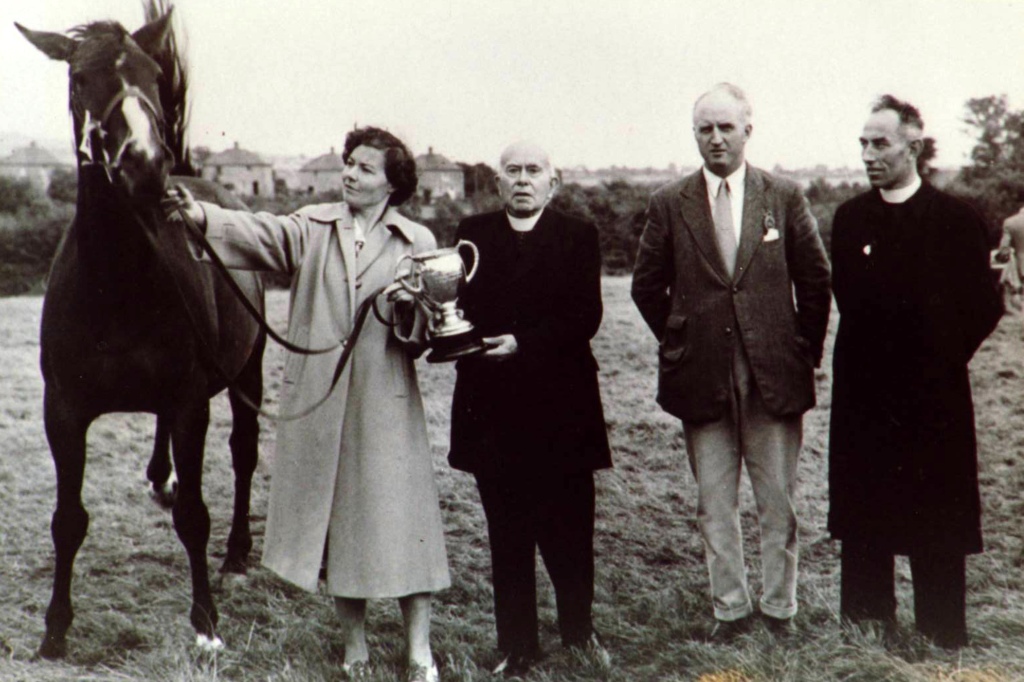
Did you ever play?
I played around a little when I was young but I never took to it, I was keener on horses, I used to hunt a bit and that was enough for me.
I think sort of being dragged over there while our elders played around and just having to go in the cold.
There was no Club House or anything?
There was but there wasn’t much, it was a sort of a hut. But we’d be around, playing around in the winter and it was so cold and you’d get bored with it after an hour and they could be three hours playing, my mother and another friend. So I was never that keen, it was a game I said that I would never play when I was grown up, too boring. I played a little bit alright but then I took up riding and hunting and that was enough to do you know because I had to go a distance then, I had to go to Limerick.
What did your parents do for recreation?
I don’t know what they did. My father loved walking anyhow because I found old letters. When my mother was in a Nursing Home I found letters when I was organising the house. He used to go down Between the Waters as they called it, that walk, he loved walking down there. I don’t what they did in those days. I mean they couldn’t move around.
He was a great athlete, he used to cycle. I think he used to cycle every day. My mother told me one time that they had a business in Ennis and he used to cycle over to see how it was going along. He was terribly keen on riding.
Can you remember the first car they had?
Yea he had a car, he was very keen on cars too, he was not keen on horses funnily enough, because naturally we had a trap, a horse and trap and then it was kept down for Granny, she used to be taken out on it.
I suppose it was one of the first cars in Killaloe. I remember he said he was going along in the car, out through Ballina and up Templehollow hill and there was an old farmer on a horse and cart and my father started hooting at him as he was in the middle of the road and naturally he had to pull up in the car and he said to the farmer ‘why don’t you pull into the side’ and the farmer said ‘ I didn’t know which side you were hooting for, so I stayed in the middle.” (laughing).
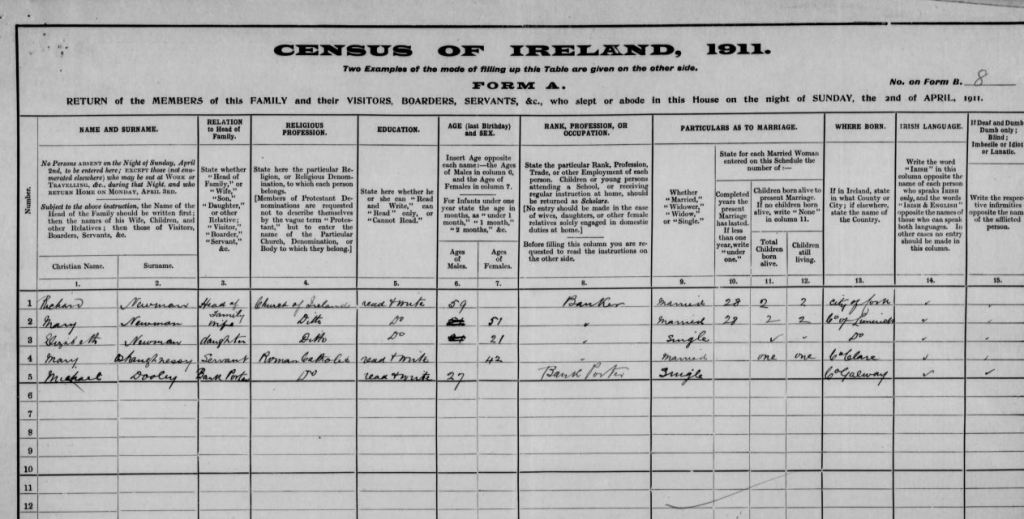
Can you remember anything about the old buildings?
Abbey House, The Bank, The Deanery and I think down at the Pier Head well I think they were built by the Martins. The Bank was built in 1900 and Newman was the first Bank Manager.
Do you know who built it?
I suppose Rafferty’s built it they were the builders at the time. It was Rafferty’s that did the extension in Abbey House, we squared it and had 2 extra bedrooms as there was only 4 bedrooms in it. The sitting room looks out onto the yard, it was a nice room so you didn’t have to stay in the dining-room all the time.
Can you remember any of the hotels?
Collins the Chemist was Thompson’s Hotel, there was a hotel on Abbey Street too, Harley’s were their names, they lived in it and people came from England for the fishing and they used to have a seat out on the footpath, an iron seat, they would sit out in the summer and read the paper. The Shannon View was another hotel, Annie McKeogh lived there on the corner beside the Anchor and she had a kind of Hotel there and then down the Cul-de-Sac where the Welsh’s are, that was The Royal Hotel and in the beginning that was the Ponsonby Hotel, it was built by The Limerick Navigation Company.
Can you remember any of the people when you were growing up?
Where Jimmy Whelan is now that house was Lucas’s and where he has his store I think that was Maloney’s, the Minogues were next and then Rafferty’s and then Ryan’s were next, they had a shop there and across the road where the slot machines are that was a drapery shop owned by Larkin’s and there was a draper shop down where Maggie Ryan was where the bus stop is and I think his name was Keane. When Jack Crowe came I think he must have bought him out and he bought the shop where Kathleen Nash is and he lived in the big house where Woods are so that was Jack Crowes shop.


